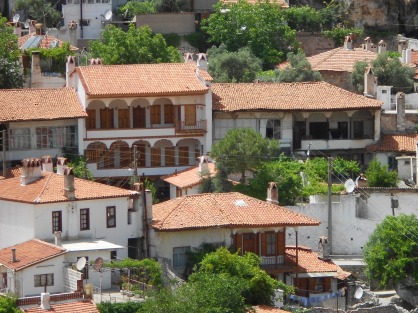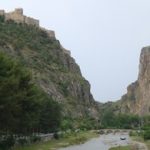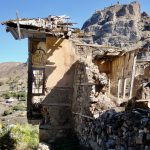Southwestern provicial capital Population: 83,000
Market day: Thursday
Old names: Mobolla (Carian-Rhodian period), Mogolla, Menteşe (Ottoman period)
Tucked away in Turkey’s southwestern corner is Muğla, a go-ahead sort of town that was the capital of the first province to have appointed a female governor (Lale Aytaman, 1991-95) and whose wide tree-lined streets would make a great blueprint for many others. It’s a delightful place with unexpected hints of Bodrum in its whitewashed back streets.
Thousands of tourists pass through Muğla evey year. The trouble is that they are usually en route for the suntraps of Bodrum or Marmaris, and linger in Muğla long enough only to cross the otogar en route from an inter-city bus to a local one. The sensible few who do venture into the town centre, however, find that modern Muğla was laid out, like New Delhi, with an eye to the future. Wide boulevards shaded by magnificent old plane trees intersect with generously proportioned roundabouts with the inevitable statues of Atatürk gazing down on them approvingly.
Even the odd pieces of modern sculpture that dot the streets are a credit to the town – and some of the statues unexpectedly reminded me of Melbourne, Australia.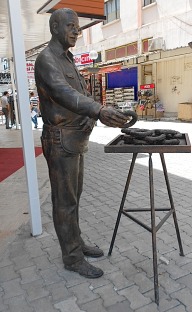
Around town
Signposts lead the visitor straight to the heart of officialdom which is housed in a set of fine 19th and early 20th-century buildings clustered around a pleasant tea garden.
One of these buildings houses the local museum (closed Mondays). It’s here that you’ll see some of the finds from the archaeological site at Stratonikeia as well as some fossils from a site at Özluce. One entire room is devoted to seven tombstones depicting gladiators that were found by chance during local coal mining near Stratonikeia. Another room contains ethnographic items including a loom once used to weave silk textiles.
Facing the museum is the Konakaltı İskender Alper Cultural Centre, housed in a wonderfully stretched-out wooden building where you can start to hone a taste for the particular characteristics of local architecture. In particular you should inspect the huge double gates which used to swing open to admit carts. Set into these are a pair of much smaller doors called kuzu kapılar (lamb doors) even though they were intended for people.
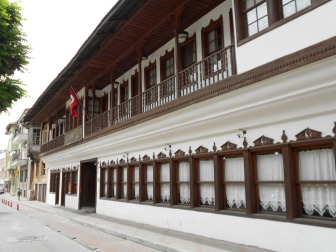 The tops of these doors have delightful intricately carved topknots reminiscent of stone carvings found in English Gothic churches of the Decorated period. It’s a style you’ll find replicated throughout Muğla as well as in nearby Milas and Akyaka.
The tops of these doors have delightful intricately carved topknots reminiscent of stone carvings found in English Gothic churches of the Decorated period. It’s a style you’ll find replicated throughout Muğla as well as in nearby Milas and Akyaka.
The Cultural Centre houses a mixed bag of exhibitions, often by local artists, as well as a bell taken from a lost church in the Saburhane district. The courtyard provides a pleasant refuge from the streets outside, a place where you may well find yourself falling into conversation with some of the local students.
Not far away, on the same street as the Cultural Centre, is the Hacıkadı Evi, an excellent example of local domestic architecture and open to the public. The first mayor of Muğla, Hacıkadızade Süleyman Efendi, had the house built in the 1870s for his son, Ömer Efendi. It’s a lovely two-storied structure set in a private garden, designed so that it looks more like a bungalow with an overhanging roof rather than the more usual sturdy style of two-storey townhouse.
The heart of the house is a lovely, brightly lit polygonal hall on the first floor with bench seats lined up under the huge windows so that the women of the family could have a constant view of the garden. Bedrooms and other family rooms open off the back of the hall while more utilitarian rooms such as the kitchen were accessed via steps down from the garden.  Later a small hamam was added to the side of the house, accessible via the servants’ quarters. Today unfortunately it has been taken over in half-hearted fashion by a local organisation involved with nomadic history. There are still a few photos of the last owners in their very Western clothing but there’s no longer any sense of the house as a family home.
Later a small hamam was added to the side of the house, accessible via the servants’ quarters. Today unfortunately it has been taken over in half-hearted fashion by a local organisation involved with nomadic history. There are still a few photos of the last owners in their very Western clothing but there’s no longer any sense of the house as a family home.
A little further along the same street a road junction is dominated by an Ottoman clocktower dating back to 1895. This could easily win a booby prize for ugliness; it looks rather as if the architect (one Filivarı Usta) had cobbled it together with a collection of materials left over from other jobs. The tower was a gift to the town from Hacıkadızade Süleyman Efendi and is worth a look if only because it retains an orginal clockface with Arabic rather than Roman numerals. It still chimes the hours today.
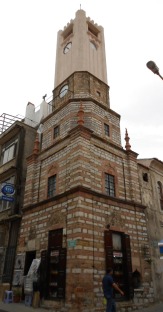 Near the clocktower are the narrow streets of Muğla’s Arasta (bazaar), shaded by ancient vines. This used to be the place to come to seek out curiosities that would never grace the shelves of glossy İstanbul shopping emporia – one ricketty old shop, for example, reeked of naphthaline, which seemed a little odd until I realised that it was a mothball shop. Now, though, it has all been tidied up and will take a while to recover its original liveliness.
Near the clocktower are the narrow streets of Muğla’s Arasta (bazaar), shaded by ancient vines. This used to be the place to come to seek out curiosities that would never grace the shelves of glossy İstanbul shopping emporia – one ricketty old shop, for example, reeked of naphthaline, which seemed a little odd until I realised that it was a mothball shop. Now, though, it has all been tidied up and will take a while to recover its original liveliness.
Many small, inviting cafe-bars and restaurants now grace the narrow streets. Particularly attractive is the Zahire-Tahil Pazarı (Grain Market), a cobbled courtyard surrounded by the rooms of what was once a medrese (seminary) but is now full of cafes and small shops. It’s immediately behind the Pazar Cami (1842).
Near the clocktower you’ll also find Muğla’s aged but unlovely Vakıflar Hamamı, once presided over by Zelihan Ana, who claimed to be 117. It still offers separate sections for men and women.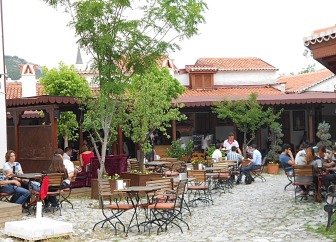
In the back streets you’ll come across the last of Muğla’s remaining historic houses. These fall into two main categories. Those backing onto the bazaar are, for the most part, lovely but fairly typical Ottoman townhouses in various states of neglect. Up on the hill and in the picturesque Saburhane district, however, the whitewashed stone houses with red-tiled roofs give the narrow streets a curiously Aegean feel.
Most of these houses were inhabited by Greeks until the 1923 population exchange. Their most striking characteristics are the soaring whitewashed chimneys, a peculiarity of this part of Turkey, with even finer examples to be seen in Çomakdağ, near Milas. The Muğla bacası (Muğla chimney) is such a feature of the town that it appears on the logo on the local authority. There’s even a model of a chimney standing in front of the old Belediye building.
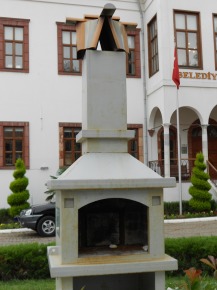 Sleeping
Sleeping
Mavi Konak
Family-run hotel in a 19th-century building with wooden balconies overlooking a central garden. Rooms are unflashy but boast big solid fireplaces. Tel: 0252-214 7007
Transport info
The nearest airport is Bodrum International at Milas.
Muğla is the transport hub for the entire southwestern corner of Turkey with frequent buses fanning out in all directions.
The bus station for both intercity and local buses is conveniently situated within wlking distance of the town centre. You can pick up buses from here to Dalaman, Fethiye, Köyceğiz, Marmaris, Milas, Ortaca and Ula. 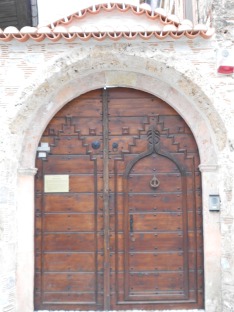 Kuzu kapılar (lamb doors) in Muğla
Kuzu kapılar (lamb doors) in Muğla
Day trip destinations
